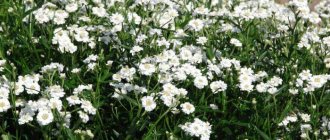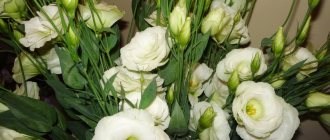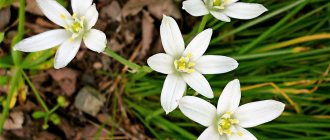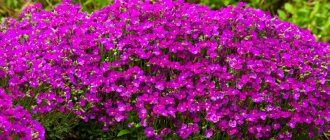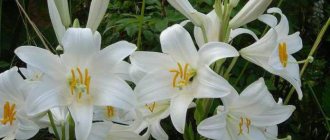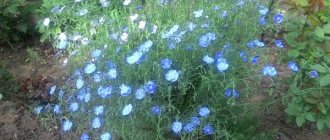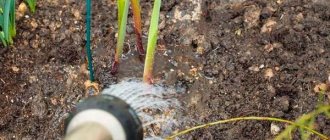Top 15 Perennial Flowers with Lilac Flowers
Many gardeners have difficulty choosing ornamental plants. This process must be approached responsibly and competently. Flowers for group planting must not only have a similar color, but also identical growing conditions. Below are the most popular types of lilac perennials.
Tulip
Herbaceous bulbous plant, up to 60 cm high. Erect tulips with a small number of sword-shaped leaves. The flowers are elongated oval in shape with a diameter of up to 7 cm.
Tulips begin to bloom 25-30 days after the start of the growing season
The perennial comes in a variety of colors. Tulips with a lilac color are bred through selective breeding.
Popular varieties:
- Peorple Dream.
- Alibi.
- Purple Prince.
- Cam Laude.
- Aria Card.
Tulips are grown in fertile, well-fertilized soil. The perennial does not tolerate dampness and waterlogging, but at the same time it is not drought-resistant.
Crocus
Herbaceous plant from the Iris family. A low-growing perennial up to 10 cm high. It has a few basal leaves.
Duration of crocus flowering – up to 20 days
The flowers of the plant are up to 5 cm in diameter. Lilac and purple crocuses are common. The most popular varieties with this color are “Flower Record” and “Remembrance”.
Azalea
A medium-sized plant that is often grown indoors or in greenhouses. There are frost-resistant varieties that can withstand up to -27 degrees. They can be planted in open ground.
Lilac azaleas need well-lit areas
The perennial is considered capricious and demanding. Regular flowering requires sunlight, nutritious soil and sufficient moisture.
Iridodictium
An early flowering perennial with a height of 10-15 cm. In summer, the plant can reach a height of 30 cm.
Iridodictium blooms in early spring and fades in midsummer
The flowers are lilac, ovoid, up to 2 cm in diameter. The petals have a specific elongated shape. Typically, the perennial is planted next to blueberries and other low-growing flowers.
Lupine
Perennial subshrub up to 1 m high. It has numerous erect stems with dense foliage. During the flowering period, panicles are formed. Lupines vary in color. In particular, there are lilac and all shades of purple.
Lupine can be planted before winter
Important! Adult specimens require hilling. This is due to the fact that their root head is gradually exposed.
The perennial requires loose and light soil. It is recommended to feed lupins every spring with nitrogen-free fertilizer.
Iris
An erect herbaceous plant with single stems. The height of some species reaches 1.5 m. It has dense sword-shaped leaves. The flowers are lilac and purple, depending on the variety.
The most popular include:
- Gala Madrid.
- He's On Edge.
- Timescape.
- Future Attraction.
- Vienna Waltz.
Irises bloom 2-3 years after planting in the ground.
Most varieties of perennials are resistant to cold and other unfavorable factors. The lilac plant can be grown in any region.
Read more Low-growing perennial flowers that bloom all summer
Rules for planting irises:
Asters
For a monochrome garden, it is recommended to choose New England purple varieties. This variety includes several herbaceous perennials, which are characterized by lilac petals.
In the middle zone, asters bloom in autumn
Many varieties can withstand frost and wind. Lilac perennial is planted in sunny areas with fertile soil. Once every 4-5 years a transplant to a new location is required.
Lilac
A common shrubby perennial. The most common lilac is the common lilac (Syringa vulgaris). The height of the perennial is up to 3.5 m. It has branched shoots and abundant foliage.
Lilac blooms up to 2 weeks
Inflorescences in the form of panicles, 2-3 pieces on each shoot. They consist of small four-petalled lilac flowers up to 1 cm in diameter.
Wisteria
A climbing tree-like perennial that is most often used for vertical gardening. The height of the plant reaches 15 m. The length of leaves on wisteria is up to 30 cm.
Wisteria blooms in mid-May
The perennial is recommended to be grown in the southern regions. Then the wisteria will bloom regularly. Drooping long panicles of lilac color with a pronounced pleasant aroma are formed on the plant.
Colchicum
A popular low-growing perennial up to 20 cm high. It has dense herbaceous shoots with long narrow leaves. The buds of most species are six-petalled.
Colchicum flowering can be repeated several times in 1 year.
The perennial blooms late - in mid-September. Flowering can continue even when frost occurs.
Hydrangea
The best varieties for a monochrome garden are Deep Purple and Rodeo Purple. They have branched shoots and large dark green leaves.
Hydrangea bush grows up to 2 m
Inflorescences of lilac hydrangea are round in shape. Less often they are hemispherical. Flowering continues from the beginning of June throughout the summer.
Phlox
For planting in open ground, varieties with a bush height of 80-90 cm are recommended. They are considered the least demanding and more resistant to frost. For a garden in lilac and purple tones, the varieties “Purple Kiss”, “Purple Eye”, “Ash Beauty” are suitable.
Phlox bushes are recommended to be planted at a distance of 40-50 cm from each other
The perennial is one of the long-flowering ones. Phlox bloom in late spring and fade only with the onset of autumn cooling.
Bells
A low-growing, unpretentious plant with small lilac and purple flowers. Bells are insensitive to frost and tolerate winter well in open ground.
Bluebells can be grown in poor, rocky soils
Bells are resistant to diseases and pests. They grow well in any conditions and do not require complex care.
Astilbe
Popular varieties of lilac color include “Purple Rain”, “Ash Lance” (Purple Lance). These are erect perennials with long paniculate inflorescences.
Astilbe flowering begins in July and lasts up to 35 days
The height of the varieties reaches 120 cm. Such perennials are ideal for decorating the garden along with other lilac plants.
Violet
Breeders have developed many varieties with lilac color for planting in open ground. Violets are not tall and have large, dense leaves.
Important! When purchasing seeds for cultivation, you need to make sure that the selected variety can be planted in open ground.
Violets require sunlight to bloom regularly.
Violets are planted in soil enriched with nutrients.
The plant needs proper care, otherwise it may die.
purple flowers
The purple color is represented by a range from burgundy, dark red to violet colors and their shades. If it is dark purple, then it is violet and burgundy; if it is light, it is lilac, mauve. Dark shades narrow the space, while light shades blur the boundaries of the flower garden and give it a romantic mood.
Related article:
Varieties and types of perennial asters
For purple flower beds, the ideal combination is different shades of purple, diluted with other colors. A place for them should be chosen in a sunny or slightly shaded area - purple looks gloomy in the shade.
Foxglove (Digitalis purpurea)
The height of the erect stems, covered with glandular hairs, reaches 1.2-2 m. Petiolate leaves (up to 30 cm) form a basal rosette, the stem leaf is sessile. A lush inflorescence is collected from large bell-shaped flowers. Varieties with purple flowers: Excelsior, Muse, Fooksi, Candy Mountainein.
Purple sedum (Sedum telephium)
The stems are erect, single or form a low compact bush with a height of 15 to 65 cm. The height depends on the variety and growing conditions. The leaf is fleshy and comes in various shades of green. Small flowers are collected in a loose inflorescence with a diameter of 3-8 cm. Flowering begins in July and lasts about 2 months. Purple sedum is an excellent honey plant that attracts pollinating insects.
Related article:
Phlox subulate in the garden
Varieties: Black Jack, Bon Bon, Picolette, Postmans Pride, Xenox.
Top 7 tall lilac perennial flowers
To create a harmonious landscape picture, it is important not only to follow the principles of color combination. Plants must be of suitable height. Many decorative varieties are compact in size. Below are garden perennial flowers with names and photos that are suitable for large areas.
Read more Perennials that bloom all summer: photos with names
Delphinium
It is an erect perennial with lush paniculate inflorescences. Lovers of lilac color should definitely pay attention to several varieties.
Among them:
- Ash Passion.
- Ash Purple Surprise.
- Morpheus (Morpheus).
Lilac delphiniums grow up to 120 cm.
The perennial prefers loamy, low-acid soils. Delphiniums are grown in places protected from strong winds.
Magnolia
Perennial tall shrub. Blooms in early May. The color of the buds is mostly bright. Some varieties bloom with purple and lilac shades.
Blooming magnolia buds fade in 20-25 days
Magnolia is an unpretentious perennial. It can be grown in any region. It does not require constant care. Periodic watering, loosening and fertilizing are sufficient.
Chrysanthemums
A beautiful tall plant with double flowers. The height of some varieties reaches 70 cm. The perennial is best suited for compact group planting.
Chrysanthemums do not develop well in shaded areas
Flowering continues until mid-autumn. Cut chrysanthemums with lilac buds can stand for up to 1 month without losing their decorative qualities.
Dahlias
An upright ornamental plant up to 110 cm high. Flower diameter is up to 18 cm. The most popular lilac dahlia variety is “Jean Marie”.
Dahlias are planted in open ground in the spring after frosts.
Dahlias can be grown in the shade. Flowers require moderate levels of humidity to avoid the risk of root rot.
Peonies
Many decorative varieties of lilac color have been bred. Erect perennial, up to 90 cm high with large double flowers.
The most popular varieties:
- Purple Spider.
- Purple Mist.
- Bowl of Beauty.
- Sapphire.
Herbaceous varieties of peonies are recommended for planting
Important! The perennial is sensitive to low temperatures. For the winter, above-ground shoots are cut off and covered.
Roses
Shrubs with lilac flowers have been bred through selective breeding. For planting in open ground, garden varieties of perennials are chosen.
Popular varieties:
- Delilah.
- Blue Parfum.
- Ash Rain (Purple Rain).
- Indigoletta.
It is necessary to choose varieties of roses that correspond to the climate zone.
It is best to purchase perennial seedlings rather than grow them from seeds. This will allow you to get a healthy plant and reduce the time for sowing seedlings.
Gladioli
This variety of perennials also includes many lilac-colored varieties. The plant is erect, up to 1 m high. The flowers are large, collected in long panicles.
In summer, gladioli need to be watered once a week.
The perennial is cut off for the winter and the bulb is dug up. It is stored indoors and planted in the ground in mid-spring.
Planting and caring for gladioli:
What are the features of cultivation and care?
Any indoor culture needs to create optimal conditions for normal growth and development. Care consists of the correct choice of substrate (soil), watering, fertilizing, creating suitable air temperature and lighting:
- Priming. Houseplants have a shallow root system, fine roots that require loose soil to grow. Therefore, ordinary soil is mixed with sand and charcoal. And for drainage they use pumice and expanded clay. These elements allow water to better penetrate the ground, from where moisture enters the roots and body of the plant.
- Pot. You need to choose the right container for growing. You need a spacious, but not very deep pot so that the roots are not crowded in it. It is recommended to give preference to ceramic and plastic options. Such containers heat up less in the sun (overheating leads to fungal infection of the roots and their rotting).
- Light. Lighting should be moderate; bright flowers do not tolerate direct, burning rays of the sun. Such crops need to be placed in slightly shaded areas. Plants develop at room temperature, but are able to survive in cool or hot conditions, but only for a short period.
How to water and fertilize?
Watering and fertilizing are mandatory procedures in caring for indoor flowers. It is recommended to water the plants early in the morning or after sunset (in extreme heat and sunlight, moisture evaporates faster from the soil and does not have time to be absorbed into the roots). When watering, you need to pay attention to the surrounding conditions: the higher the air temperature, the more abundant the moisture should be. This means that in spring and summer, purple flowers are moistened 2-3 times a week; in winter, it is recommended to reduce watering.
The soil is fertilized in the spring, when the roots and other parts of the plant are in a state of active growth. During this period, nutrients are more readily absorbed by the crop, and accordingly, the procedure gives better results. If necessary, for example, if poor soil is used, it is recommended to repeat fertilizing in the fall.
Important! The type of product is chosen depending on the plant variety. Most often, nitrogenous compounds or silicates are used. They are diluted with water in the ratio indicated on the package and poured into the soil, being careful not to touch the roots.
Transfer
It is recommended to replant indoor plants in early spring, when all life processes are activated after winter dormancy. It is necessary to carefully remove the flower from the pot without touching its roots. Drainage is placed in the container for transplantation and a little soil is poured. Place the plant there, sprinkle it with substrate, and moisten it abundantly.
Carefully! It is not recommended to fertilize immediately after transplantation. The plant needs time to take root in its new growing location.
It is better to fertilize and prune crops 2-3 weeks after they are moved to a new pot. This procedure must be carried out as the plant grows, since some varieties require frequent replanting, others - once every 2-3 years.
Diseases and pests
Often, a houseplant begins to turn yellow, turn black, and its leaves become covered with spots and wormholes. The reason for this is diseases and attacks by insect pests.
Diseases are divided into viral and bacterial. The most common viral pathologies of domestic plants include mosaic and plant jaundice. The first disease, if treated in a timely manner, does not cause serious harm, but worsens the appearance of the crop, as it is accompanied by the appearance of yellow spots on the leaves. Jaundice is considered a more dangerous pathology, as it leads to rapid withering and death of the flower.
Bacterial diseases include:
- Rot (often forms on dense, fleshy leaves). The main reasons are increased air humidity and abundant use of nitrogenous fertilizers.
- Withering. With proper care, the plant begins to turn yellow and wither, which means it is affected by pathogenic bacteria.
- Dark and yellow spots. Unlike mosaics, they have a clear outline, which indicates bacterial damage.
- Bacterial cancer. Durable growths appear on the stems and shoots, which interfere with normal metabolism. As a result, the plant gradually dies.
Indoor flowers are also susceptible to pests, such as:
- spider or soft-bodied mite;
- aphid;
- scale insect;
- thrips;
- whitefly;
- felt
Important! If symptoms of the disease are detected, the affected parts of the plant must be removed immediately before the disease spreads to healthy areas.
The plant must be treated with an insecticide; if necessary, repeat this procedure after 14 days until all symptoms disappear completely.
Top 10 Perennials with Purple Flowers
Designing a monochrome garden does not necessarily involve growing plants of identical colors. Violet and purple ornamental crops are usually planted together with lilac-colored perennials.
Aconite
Herbaceous perennial up to 100 cm in height. It has sparse small foliage and small purple flowers.
The height of aconite inflorescences is up to 40 cm
Important! The plant contains toxic substances that can cause poisoning if ingested.
Aconite is frost-resistant, can withstand temperatures down to -23 degrees. Insensitive to droughts and lack of fertilizing.
Read more Perennial flowers for the Moscow region, blooming all summer: photos, top best
Clematis
A variety of perennial with purple flowers is included in a separate group - Clematis viticella purpurea. It is a climbing plant up to 4 m high.
Clematis blooms for an average of 2 months
The decorative effect of the plant remains after the buds wither. Dense foliage remains on the shoots, which does not turn yellow until late autumn.
Ageratum
An herbaceous perennial grown from seeds. It has erect stems with numerous side shoots. Blooms in mid-June. Purple round flowers appear on the stems, which fade in early autumn.
Perennial ageratum is a heat-loving plant that does not tolerate cold.
The weak point of perennials is considered to be susceptibility to disease. Therefore, it must be treated regularly for preventive purposes.
Brachycoma
A low-growing herbaceous perennial with small (up to 5 cm in diameter) purple and pink flowers. The plant has thin light green stems with many small leaves.
Brachycoma height – up to 40 cm
The perennial grows well on rocky, poor soils. Lack of nutrients does not affect the frequency and flowering.
Hesperis
Large specimens reach 120 cm. Average height is 50-60 cm. Erect perennial with many side shoots.
Hesperis blooms in the evening, after sunset
The perennial is widely used as an ornamental plant. It is known for its beautiful purple flowers with a strong scent.
Geranium
A perennial subshrub, which is often grown at home. A few hybrid varieties are intended for open ground. They are unpretentious and resistant to harmful factors.
Geranium can be grown both in illuminated areas and in the shade
The perennial does not grow well in clay soils. The plant requires a nutritious, well-drained substrate with peat and compost.
Hyacinth
In a monochrome garden, it is recommended to grow varieties “Royal Novi”, “Amethyst”, “Bismarck”. They are a beautiful purple color with large, up to 4 cm, flowers.
Hyacinth height – up to 30 cm
The perennial blooms for up to 1 month. Under favorable conditions, it blooms twice a year.
Lilies
In garden stores you can buy seeds of hybrids with purple flowers. Among the most common are the varieties “Ash Lady” and “Ash Prince”.
Flowering of lilies lasts from 60 to 90 days
The height of the bush is up to 120 cm. In the lower part, the perennial has long sword-shaped basal leaves.
Heliotrope
A low shrubby plant with cluster-shaped dark purple inflorescences. Grows well both outdoors and indoors. Characterized by long flowering - up to 4 months.
Heliotrope inflorescences turn to follow the sun during the day
The perennial is planted in lighted areas. Otherwise, the shoots begin to stretch during flowering and may break under their own weight.
Zopnik
An erect perennial up to 150 cm high. It has a branched stem. Violet and lilac flowers are formed on shoots in 2 tiers. The buds are small, with slight pubescence.
Zopnik blooms in July-August
The perennial grows best in the southern regions. A well-lit, windless place is recommended for planting.
Shades of purple in landscape design
Purple is considered a “cool” color and includes many shades. Some of them have their own name associated with a natural standard, for example, light purple is lilac, violet is deep purple, lilac is pale shades of dark purple, bright and rich purple is lavender. Magenta (magenta) is sometimes considered a shade of violet, although it is made by mixing red and violet (blue).
Related article:
5 varieties of Fallopia for your garden: Secrets of cultivation
When choosing a place for such flowers, you need to take into account that in the bright sun the color gradually fades and fades, so it is good if the area is a little shaded at midday. In the shade you won’t have to count on bright colors, but the “neighbors” will save the situation - plants with light or silver leaves, decorative filling in light colors.
Recommendations for using purple flowers:
- cool colors look great both in monochrome combinations and in contrasting ones when white, yellow, cream, apricot colors are added;
- creating a bright accent against a background of light colors;
- a variety of shades gives volume to the space, visually distances the object (for example, a path decorated with lavender or catnip seems longer);
- a composition with white, cream, silver flowers will give the flower garden lightness and airiness;
- Based on purple perennials, you can create compositions in different colors every year.
Related article:
Mullein for your garden: types, description and secrets of growing
The meaning of purple flower plants for flower beds and flower beds
The first feature of purple flowers:
This color, like its neighbor on the color spectrum blue, is cold, but contains a share of red, making it look more lively and cheerful.
The most beautiful compositions are those in which purple flowers are combined with plants of light shades, related to warm tones.”
Bushes with this flowering look even darker against the background of the lawn; the contours of the flowerbed become too blurred, merging with the background, so it is not recommended to plant only them, without annuals and perennials of other shades.
In the photo below, the purple flowers look too simple, so they are not diluted with other shades.
The third rule of purple flowers.
Purple-colored plants look like they are located much further back than they actually are, so when planted in the background of a flower bed, they visually increase the space behind it.
Lilac and purple shades also belong to this color, but only blurred. They are more transparent, so they need to be supplemented with perennials or annuals of warm shades when planted in flower beds.
